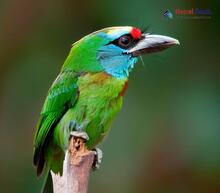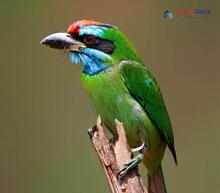Located in the heart of South Asia, Nepal is renowned not only for its magnificent mountains and rich cultural history but also for being home to numerous bird species, including the mesmerizing Psilopogon genus. These colorful and charming birds, also known as Asian Barbets, are part of the Megalaimidae family. Here, we will take a journey through the fascinating realm of Psilopogon birds and investigate their distinctive traits, environments, and significance within Nepal's thriving ecosystem.
Traits of the Psilopogon Genus
The appearance of Psilopogon birds is bright and eye-catching, setting them apart from other bird species. They are small to medium-sized with robust bodies and powerful beaks suited for their primarily frugivorous diet. The beautiful plumage showcases a mix of green, blue, red, and yellow hues, which delight birdwatchers and nature lovers alike.
In addition to their gorgeous looks, Psilopogon species are valued for their unique calls. These loud and resounding sounds echo throughout the dense forest canopies they inhabit. Each species within this genus has its special song pattern that is often audible over long distances.
Nepal's Habitats and Distribution of Psilopogon
Nepal provides a wide variety of habitats that cater to different Psilopogon species. These captivating birds chiefly reside in forests and wooded regions where they have access to plentiful food sources such as fruits and insects. Some species prefer dense understory and thickets near forest borders while others flourish at higher altitudes around hills and mountains.
Notable Psilopogon species found in Nepal include the Great Barbet (Psilopogon virens), Blue-throated Barbet (Psilopogon asiaticus), and Golden-throated Barbet (Psilopogon franklinii). These birds are frequently seen in protected areas like Shivapuri Nagarjun National Park, Langtang National Park, and Annapurna Conservation Area.
The Impact of Psilopogon on Nepal's Ecosystem
The Psilopogon genus significantly contributes to the well-being of Nepal's ecosystems. These birds act as vital pollinators and seed dispersers due to their fruit and berry diet. By eating these food sources, Psilopogon species assist in spreading seeds throughout their environments, which promotes the growth and rejuvenation of vegetation.
Moreover, the presence of Psilopogon birds in an area often signifies a flourishing and biodiverse ecosystem. Their existence can indicate the overall health of a forest or woodland habitat, making them ideal species for monitoring biodiversity trends in Nepal.
In summary, the Psilopogon genus is just one of the many bird wonders hidden within Nepal's abundant biodiversity. These extraordinary birds captivate us with their vivid colors and enchanting melodies while also playing a vital role in sustaining their ecosystems' balance. As we continue to focus on conservation initiatives in Nepal, it is essential to protect not only these fascinating birds but also the distinct habitats that support diverse plant and animal life.




